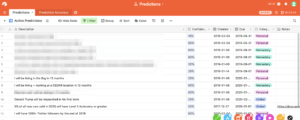I don’t think of myself as a betting man, so I was surprised to learn that in fact, we’re making bets all of the time. This is Annie Duke’s main thesis in Thinking in Bets.
Duke shares how she mastered thinking probabilistically through playing professional poker, and then went far beyond it. Duke argues that bets are the best way to describe how we act on information. By thinking in bets, we can make better and better decisions. Mike Fishbein shares many of the best lessons from the book in this terrific blog post.
Interesting non-fiction books offer a compelling, refined way of seeing something. This feels helpful and clarifying – but it hasn’t actually helped you yet. The onus is on you, the reader, to do something with what you read. You need to learn it. You need to apply it. Otherwise, reading is just the intellectual equivalent of absentmindedly watching Netflix on the couch after a long day.
I was curious to find a creative way to make the information in Duke’s book actionable for myself. Playing poker seemed like an obvious choice. I don’t know how to play poker, and I love playing games. But for whatever reason, poker just doesn’t interest or excite me. I did want to start thinking with probabilities, though, so it could start to impact my projects and responsibilities.
So I started asking around – how did other people think probabilistically? How did they encounter these ideas? How did they apply them?
A friend told me that he had been tracking predictions in an Airtable. This seemed like a fun, safe-to-fail experiment, so I set it in motion.

Even after using the Airtable for a few days, I noticed a number of positive outcomes. I started to notice when I was falling into black and white thinking: “it will happen” or “it won’t happen.” That would trigger me to assess chances instead, and then to prepare for multiple possible outcomes.
Tracking predictions again and again has fine-tuned my ability to predict the future. One example is that I predicted early in my experiment that in six months, I would be living in the Bay Area. But it turns out I’m living back in Vermont, since I moved across the country! I’ve consistently noticed that things that I’m very confident of are less likely to be accurate, while things that I’m less confident are more likely to be accurate.
As a bonus, this has helped me to get more familiar with maintaining a database with Airtable. I had already used Airtable for managing a personal CRM, but I knew I could be making better use of its features.
Since then, I’ve started using Airtable more and more at work. I’ve also had a chance to start using probabilistic thinking there.
Since I’m doing a lot of work fundraising for our non-profit, we’ve started using Opportunity Value to calculate the estimated probability of success with each opportunity. Using this concept is standard practice in non-profits and sales, but was new for me personally. Opportunity Value is just the estimated value (e.g. $10,000) multiplied by estimated probability (40%). That means that the opportunity is worth $4,000.

Of course, you need to have good information and methods for estimating probability collectively, in context, but this isn’t that hard. It’s even easier if you’ve already done the work of learning to think probabilistically.
One unexpected facet of this experiment is how vulnerable it is. I really wouldn’t want to share many of my predictions. We may already making “bets” all the time, but it’s not necessarily polite to voice our predictions.
If you want to give this method of developing probabilistic thinking a try, here’s a template you can use. If you learn anything, or improve the template, let me know!
Subscribe to my newsletter, my YouTube channel, or follow me on Twitter to get updates on my new blog posts and current projects. You can also support my work and writing on Patreon.
